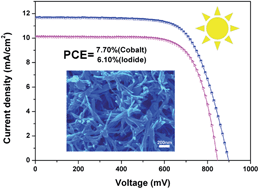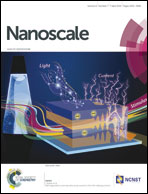Titania nanobundle networks as dye-sensitized solar cell photoanodes†
Abstract
Quasi-one-dimensional (1D) titania nanobundles were synthesized via a hydrothermal method and used to print random network nanostructured films. These films are shown to be ideally suited for application as photoanodes in dye-sensitized solar cells (DSCs) as they have a higher porosity compared to the traditional 1D nanostructured TiO2 materials. Devices constructed using the N719 dye and iodide/triiodide as the redox mediator in the electrolyte yielded energy conversion efficiencies (η = 6.1 ± 0.2%), which were marginally lower than for devices made with the commonly used P25 titania films (η = 6.3 ± 0.1%) under one sun simulated solar radiation. Application of an electrolyte based on the [Co(bpy)3]2+/3+ redox couple and the MK2 organic sensitizer resulted in higher efficiencies (η = 7.70 ± 0.1%) than for the P25 devices (η = 6.3 ± 0.3%). Each performance parameter (short circuit current density, open circuit voltage and fill factor) was higher for the TiO2 nanobundle devices than those for the P25-based devices. The results of electrochemical impedance spectroscopy (EIS), intensity-modulated photovoltage spectroscopy (IMVS), and dye-loading measurements indicated that the better performance of TiO2 nanobundle devices with cobalt electrolytes correlates with higher porosity, relatively fast electron transport and more efficient suppression of electron recombination. A faster rate of diffusion of the cobalt complexes through the highly porous TiO2 nanobundle network is proposed to contribute to the enhanced device efficiency.


 Please wait while we load your content...
Please wait while we load your content...